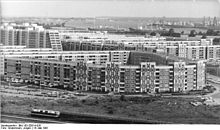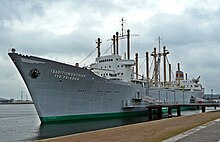Schmarl
|
Schmarl
City of Rostock
Coordinates: 54 ° 8 ′ 0 ″ N , 12 ° 4 ′ 18 ″ E
|
|
|---|---|
| Height : | 5 m above sea level NN |
| Area : | 5.8 km² |
| Residents : | 8756 (Dec. 31, 2017) |
| Population density : | 1,510 inhabitants / km² |
| Incorporation : | March 8, 1934 |
| Postal code : | 18106 |
| Area code : | 0381 |
|
Location of Schmarl in Rostock
|
|
Schmarl is a district in the northwest of the Hanseatic city of Rostock . It was built between 1976 and 1984. The district was named after the Warnowdorf Schmarl in the northeast of this district.
history
The place Schmarl was first mentioned in 1272 under the original Slavic name "Smerdele". In High German, this word means “stink beetle”. Another assumption is that the term was derived from a personal name or an old name for peasants. The place name Hundsburg reminds of the long history of the place right between today's large housing estate and the Warnowufer . The Hundsburg was first mentioned in 1152 and was an important strategic point in the early Middle Ages, from which the approach of ships to Rostock could be controlled. According to legend, Queen Margaret of Denmark, who was in distress during a storm, was rescued by fishermen here. Allegedly in gratitude for this, the queen donated the Cistercian nunnery Kloster zum Heiligen Kreuz in 1270 . The castle was demolished in 1582. The village of Schmarl was the main property of this monastery until the Reformation.
In 1886 the Rostock-Warnemünde railway line went into operation and Schmarl was given a train station. After the railway line was swiveled due to the Heinkel aircraft industry being built further south, a new station was built in 1934. On March 8, 1934, the place was then incorporated into Rostock. However, Schmarl only became part of the modern city of Rostock at the end of the 1970s, when the large housing estate was built in prefabricated construction with 6,549 apartments for around 16,000 people from 1976 (without subsequent densification ) . The location of the residential complex was bounded by the city motorway and the S-Bahn, which opened in 1974, to the west, by a wetland area to the north and the Marienehe industrial park to the south. The planners had models of the new district tested in the wind tunnel of the Dresden University of Technology to ensure protection from the harsh Baltic Sea climate. When the residential area was built, the former Rostock - Warnemünde railway was built over, but the former station building was retained. The streets of Schmarl were named after the names of famous seafarers and explorers, e.g. B. Stephan Jantzen , Vitus Bering and, fittingly, after the fall of the Wall (Christoph) Columbus (formerly Nikolai-Kusnetzow -Ring).
Before 1989 there were five schools, five day-care centers , two department stores, a cinema and a library in Schmarl . After the reunification, however, like practically all industrially built districts, the district was affected by the emigration of mostly higher-income residents. In the meantime, however, this trend has reversed, so that today more than 8,000 people live in Schmarl again. This is due not least to the advanced modernization of the apartments and various funding programs to improve the district. Nevertheless, Schmarl is also affected by the dismantling. In addition to a few rows of living quarters, a former kindergarten and a school, some segments of the Columbus Ring were torn down for the first time in the spring of 2009, thus creating gaps in the previously closed street front. The increasing efforts to reduce the number of floors will change the image of this district of Rostock in the future.
Attractions
Due to its short history, the modern Schmarl does not, of course, contain any significant cultural and historical sites. However, its architectural design is to be classified as extremely interesting, as Schmarl is the only one of the seven large Rostock housing estates to have "living snakes" which actually have predominantly round shapes and make the monotony of conventional prefabricated buildings partially forgotten. The exterior design of the buildings with clinker brick and colored surfaces that pick up on medieval brick elements and ornamentation is also varied. With foresight, oak stocks were planted as early as the 1960s, which today loosen up the district even more. On the banks of the Warnow in the village of Schmarl, the two ships, the traditional ship type Frieden (which has been converted into a floating ship museum) and the Likedeeler (a floating youth and leisure facility with a school camp) , are moored here . The area around the Schmarler Bach in the north of the district attracted 2.6 million guests from all over the world to Rostock for the International Horticultural Exhibition (IGA) 2003 from April to October 2003 . Previously, parts of the area had been used as rinsing areas, where the dredged material (sand, silt) could drain from the port approaches. Together with the new park at the Hundsburg, the area is now the district's attractive local recreation area. Adjacent is the Rostock exhibition center, which was built in 2003 and is one of the most important event centers in Mecklenburg-Western Pomerania.
economy
After reunification, two additional shopping centers were built in Schmarl with the Messeblick and the Columbus Passage. Due to the reduced number of inhabitants and the changed traffic routing through the new Warnow tunnel, Schmarl now has less purchasing power, so that some commercial space is currently vacant. Nevertheless, the district with two supermarkets in the residential area and around 20 specialty shops still offers a satisfactory supply of services and goods for daily needs. Needy residents are supported by a social department store, a “Carisatt” shop and a distribution point from Rostocker Tafel eV. The Schmarler offer in the health sector currently includes 16 medical practices, two pharmacies, two physiotherapists, midwives and various other medical service providers. The district also includes the Schmarl-Marienehe industrial park to the south, which is of considerable economic importance for Rostock with a large number of different companies. There is also a wholesale market and the HCC (Holiday City Center) with a wide variety of leisure activities.
Education, culture and social issues
In relation to its size, Schmarl has a wide range of social and cultural options. There are three day-care centers in the district, a primary school and the secondary Krusenstern school. Schmarl also houses the business school of the Hanseatic City of Rostock. Two sports halls, two soccer fields, four small sports fields as well as a beach volleyball field and a skate facility are available as sports facilities. Places of neighborly and cultural encounters are the children, youth and family center "House 12" in the north and the "Treffen eV" in the south of the district, as well as the youth club "Schiene" in close proximity to the school center. There are also numerous other institutions and organizations, such as B. the evgl.-luth. Ufergemeinde, the union unemployment service “Dau Wat”, the AWO senior meeting place and the youth ship “Likedeeler”. The Schmarler Folk Choir is known beyond the borders of the district.
traffic
Schmarl owns one of two privately operated road tunnels in Germany that are subject to tolls. It runs under the Warnow and got its name from this river, Warnowtunnel . It connects Schmarl with Oldendorf on the eastern bank of the Warnow and is 790 m long, so that the A19 motorway can be reached in a few minutes by car. With the tunnel, an expressway was created on the northern edge of Schmarl, which is connected to the B 103 city motorway .
Until around 2000, only peripheral bus routes operated, so that long footpaths had to be covered to reach public transport. In terms of local transport, Schmarl is now very well connected to the other districts of Rostock by the S-Bahn and various bus routes.
During the IGA 2003 , a cabin cable car ran over the garden show grounds. For the duration of the exhibition, the Lütten Klein S-Bahn station, which also serves Schmarl, was also a stopping point for several intercity trains.
Web links
Individual evidence
- ↑ Population by city area on rathaus.rostock.de
- ↑ Dr. Hartmut Schmied: How the Hundsburg got its name. Hanseatic City of Rostock, accessed on September 23, 2016 .
- ↑ Lothar Schultz, Josef Temmen: The Rostock S-Bahn - Warnemünde . Kenning, Nordhorn 2004, p. 38 .
- ^ Karsten Schröder: Rostock's city history . Ed .: Karsten Schröder. Hinstorff, Rostock 2013, ISBN 978-3-356-01570-6 , p. 326 .






